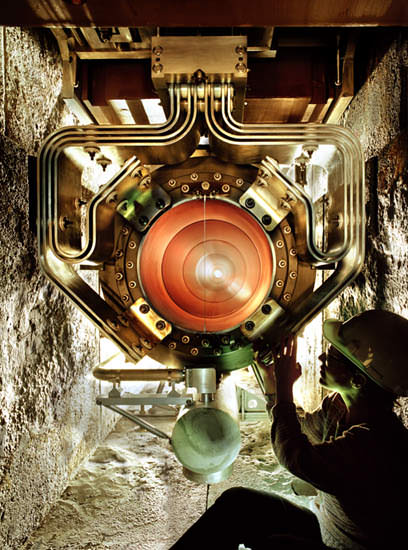[/caption]
Right when you thought that Fermilab was a thing of the past, new work with neutrinos are exciting us all over again. The scientists associated with the MINOS experiment at the Department of Energy’s Fermi National Accelerator Laboratory just announced their findings of a rare phenomena – the transformation of muon neutrinos into electron neutrinos.
On June 14 the Japanese T2K experiment also found clues to this type of transformation. These dual reports could have a profound impact on the way we understand how neutrinos impacted the evolution of our Universe. What burning question do the results answer? Try why there is more matter than anti-matter. If muon neutrinos transform into electron neutrinos, neutrinos could be the reason.
“The Main Injector Neutrino Oscillation Search (MINOS) at Fermilab recorded a total of 62 electron neutrino-like events. If muon neutrinos do not transform into electron neutrinos, then MINOS should have seen only 49 events.” says Fermilab. “The experiment should have seen 71 events if neutrinos transform as often as suggested by recent results from the Tokai-to-Kamioka (T2K) experiment in Japan.”
Using entirely different methods, the two neutrino experiments went to work. To measure the transformation of muon neutrinos into other neutrinos, the MINOS experiment sends a muon neutrino beam 450 miles (735 kilometers) through the Earth from the Main Injector accelerator at Fermilab to a 5,000-ton neutrino detector, located half a mile underground in the Soudan Underground Laboratory in northern Minnesota. The nearly twin detectors have different purposes. At Fermilab the purity of the muon neutrino beam is calibrated while Soudan detects electron and muon activity. It’s a fast trip, too…but just one four hundreths of a second is all it takes for these incredibly tiny particles to transform.
“Science usually proceeds in small steps rather than sudden, big discoveries, and this certainly has been true for neutrino research,” said Jenny Thomas from University College London, co-spokesperson for the MINOS experiment. “If the transformation from muon neutrinos to electron neutrinos occurs at a large enough rate, future experiments should find out whether nature has given us two light neutrinos and one heavy neutrino, or vice versa. This is really the next big thing in neutrino physics.”
For more information read the Fermilab Press Release.


This means that sin^2(?_{12}) is a bit bigger than previously thought. It is large enough so that short ranged neutrino oscillation could be measured.
LC
“.. (MINOS) at Fermilab recorded a total of 62 electron neutrino-like events. .. The experiment should have seen 71 events if neutrinos transform as often as suggested by recent results from the Tokai-to-Kamioka (T2K) experiment in Japan.”
Using entirely different methods, the two neutrino experiments went to work.”
The implication seems to be that different detectors (or maybe methods of generation) give different results. The numbers are small but if that difference is maintained, what would that tell us?
It would be tough if there is a device dependency here. I am not going to reproduce the PMNS matrix argument I wrote up a couple of weeks ago, but it leads to a probability for transitions
P = sin^2(2?)sin^2(?m^2L/4E)
Where ? is the mixing angle from the PMNS matrix and ?m is the mass splitting between the two neutrinos. The data indicates sin^2(2?) e neutrino mixing angle and that the mass gap is about .05ev. The energy E above is the energy at which the mass eigenstate is obtained ~ 100MeV and L is the length the neutrino travels in inverse energy units. The time of travel is t corresponds to energy e ~ ?/t, and this inverse energy unit is t/? with t ~ 2.45×10^{-3}sec (FNAL to Soudan time of flight) and ? = 4.1×10^{-15}ev/sec. So we then have L ~ 5.97×10^{11} ev^{-1}. So this all gives
?m^2L/4E ~ 5,
Which means over that time the ? — > e neutrino oscillation has executed over a 180 degree period. The probability is then approximately 7.×10^{-3} over that distance. The mass gap between neutrinos has error bars that are only one order of magnitude smaller than the value used here. This probability is then probably only correct or certain within about an order of magnitude. So theory is a bit uncertain.
The data also has some error margin as well. There would be zero for 49 neutrinos obtained, and the T2K obtained 71. This comparison of data and the recorded 62 at Soudan suggests we have a data spread of 13 for Soudan and 22 for T2K. A Poisson estimate of the error margin with the Soudan data ?N =~ 4, which is not far from a spread that would overlap the T2K data. I think that at this time the data sets are comparatively limited, and I hope these data points are at least greater than 3 sigma, so it is likely this reflects a rather large level of measurement uncertainty.
LC
Thanks, it certainly sounded as though the data need to be more robust.
The Standard Model doesn’t seem to predict the observed matter-antimatter symmetry breaking. (Or at least all of it.) Then it should be promising that neutrino masses, which are outside (todays) Standard Model, may provide the sought for prediction.